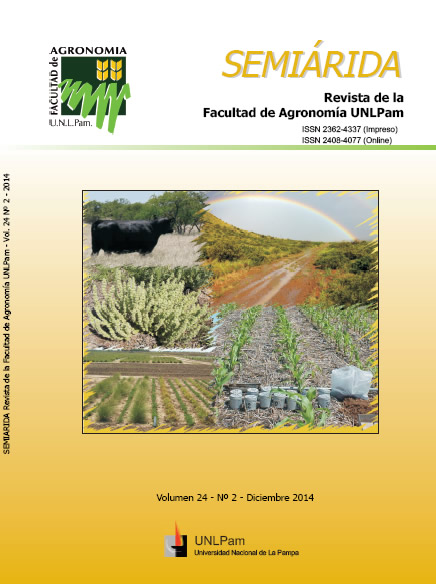Ver ítem
- xmlui.general.dspace_homeCentros Regionales y EEAsCentro Regional La Pampa - San LuisEEA AnguilArtículos científicosxmlui.ArtifactBrowser.ItemViewer.trail
- Inicio
- Centros Regionales y EEAs
- Centro Regional La Pampa - San Luis
- EEA Anguil
- Artículos científicos
- Ver ítem
Producción y calidad del forraje de alfalfa con gramíneas megatérmicas en el año de implantación = Forage production and quality of warm season grasses associated with alfalfa in the semiarid pampas in the implantation year
Resumen
El objetivo fue evaluar la producción de forraje, proteína bruta (PB), fibra detergente neutro (FDN) y digestibilidad estimada de la materia seca (DEMS) en pasturas asociadas de alfalfa y gramíneas C4 en comparación con alfalfa pura durante su primera estación de crecimiento. Los ensayos se establecieron en dos localidades, Anguil y Castex (La Pampa, Argentina), en un diseño en bloques completos al azar, con parcelas de 6,25 m2 y surcos a 25 cm
[ver mas...]
El objetivo fue evaluar la producción de forraje, proteína bruta (PB), fibra detergente neutro (FDN) y digestibilidad estimada de la materia seca (DEMS) en pasturas asociadas de alfalfa y gramíneas C4 en comparación con alfalfa pura durante su primera estación de crecimiento. Los ensayos se establecieron en dos localidades, Anguil y Castex (La Pampa, Argentina), en un diseño en bloques completos al azar, con parcelas de 6,25 m2 y surcos a 25 cm intercalados de alfalfa (A) cv Victoria (grupo 6) y una de las siguientes gramíneas C4 Tetrachne dregei (TD), Panicum coloratum (PC), Digitaria eriantha (DE) y Eragrostis curvula (EC), más un testigo (alfalfa pura). Se realizó un análisis de medidas repetidas usando un modelo mixto con localidades y asociaciones fijos y bloques aleatorios y prueba DMS (p<0,05). Para producción de alfalfa se detectaron efectos de localidad y tratamiento. La mayor acumulación de forraje de las mezclas respecto de alfalfa estuvo asociada a mayor proporción de megatérmicas. Para producción de forraje de gramíneas, de la mezcla, FDN, DEMS y PB los efectos principales y las interacciones resultaron significativos. En base a su producción de forraje y calidad PC, DE y EC serían las gramíneas C4 más promisorias para asociar con alfalfa; mientras que TD mostró la menor biomasa. Las asociaciones de alfalfa con gramíneas C4 permitieron, durante la primera estación de crecimiento, incrementar la producción respecto de alfalfa. Esto debería confirmarse utilizando otras variedades de alfalfa y períodos más largos.
[Cerrar]
The aim of this work was to evaluate yield, concentrations of crude protein (CP) and neutral
detergent fiber (NDF), and dry matter digestibility (DMD) of forage produced during first
growing season by pastures of alfalfa associated with warm-season (C4) grasses compared
to that of alfalfa as a single component. Trials were conducted at sites of Anguil and
Castex, La Pampa province, Argentina using a randomized complete block design, plots
of 6.25 m2
[ver mas...]
The aim of this work was to evaluate yield, concentrations of crude protein (CP) and neutral
detergent fiber (NDF), and dry matter digestibility (DMD) of forage produced during first
growing season by pastures of alfalfa associated with warm-season (C4) grasses compared
to that of alfalfa as a single component. Trials were conducted at sites of Anguil and
Castex, La Pampa province, Argentina using a randomized complete block design, plots
of 6.25 m2 size and seeding in rows separated 25 cm from each other. A single cultivar of
alfalfa (A), Victoria INTA (Group 6), was used for the experimental work and, in the case of
associations with C4 grasses, the establisment of plants was in an alternate pattern with
rows allocating one of the following species: Tetrachne dregei (TD), Panicum coloratum
(PC), Digitaria eriantha (DE) and Eragrostis curvula (EC). Treatments tested were: A (control),
A+CE, A+PC, A+DE and A+TD. Results were treated by repeated measures analysis
of variance, using a mixed model with treatments and sites representing the fixed effect
and blocks the random one, and comparison of treatment means by LSD test (p<0.05).
For alfalfa forage production, significant differences were detected among sites and treatments.
The higher accumulation of aerial biomass observed in mixed pastures was associated to the contribution of C4 grasses. The main effects and interactions were significant
for grass forage production, total mixed forage production and grass variables of forage
quality (CP, NDF and DMD). Considering their forage production and quality, PC, DE and
EC would be more promising in pastures mixed with alfalfa, whereas TD does not stand
out because of its lower aerial biomass accumulation. During the first growing season, associations
of A with C4 grasses showed a greater forage production in comparison to pastures
with A as single component. However, this should be confirmed using other alfalfa
genotypes and by tests lasting longer periods of time.
[Cerrar]

Fuente
Semiárida : Revista de la Facultad de Agronomía, Universidad Nacional de La Pampa 24 (2) : 21-29. (2014)
Fecha
2014
Editorial
Facultad de Agronomía, UNLPam
ISSN
2362-4337
2408-4077 (Online)
2408-4077 (Online)
Formato
pdf
Tipo de documento
artículo
Palabras Claves
Derechos de acceso
Abierto
 Excepto donde se diga explicitamente, este item se publica bajo la siguiente descripción: Creative Commons Attribution-NonCommercial-ShareAlike 2.5 Unported (CC BY-NC-SA 2.5)
Excepto donde se diga explicitamente, este item se publica bajo la siguiente descripción: Creative Commons Attribution-NonCommercial-ShareAlike 2.5 Unported (CC BY-NC-SA 2.5)


